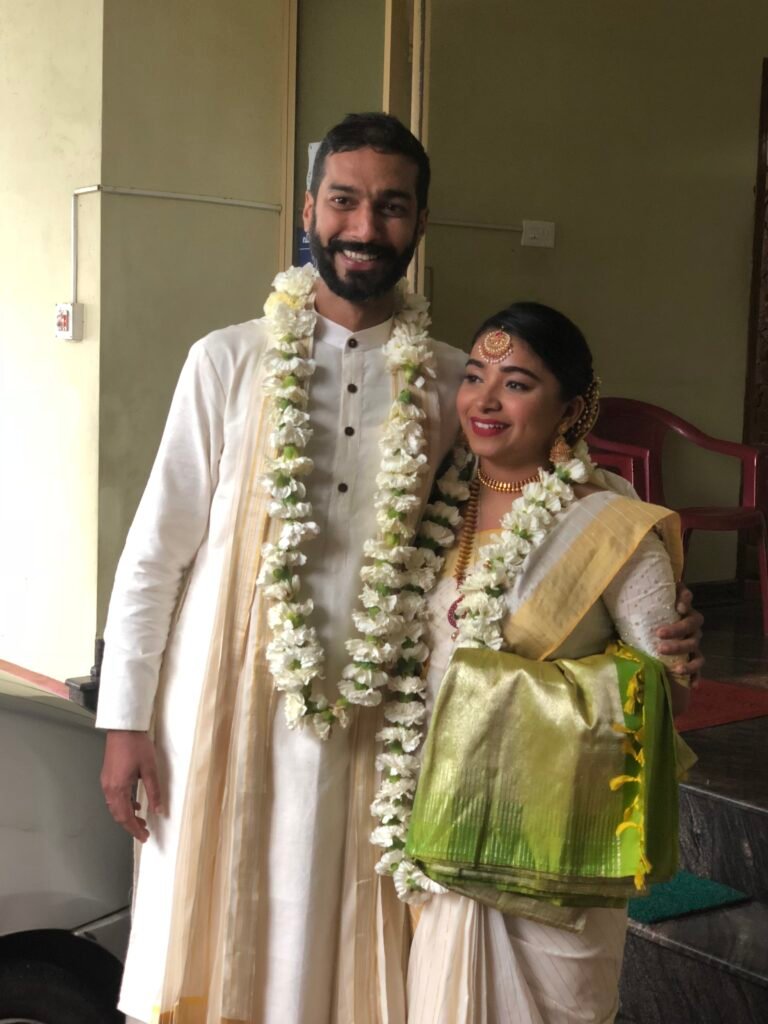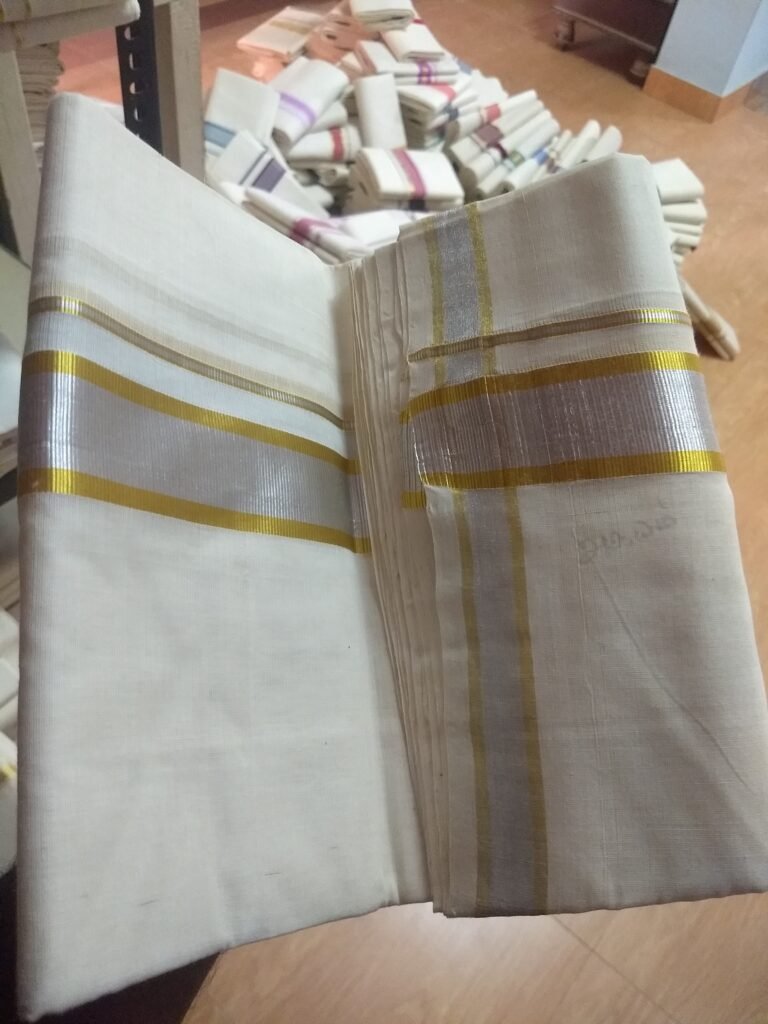Wedding Attire- Thoma & Rekha
A close friend wanted to deviate from the typical western suits worn for christian wedding to something that was more suitable for Kerala climate. The groom and family had their white and gold wardrobe designed by me & woven at Balaramapuram, a traditional handloom village in Kerala.

Handloom History of Kerala – Balaramapuram
The handloom cluster, Balaramapuram is a small village in Thiruvananthapuram district of south Kerala, which is famous for fine cotton sarees and dress materials. The Balarampuram sarees are well known for its simplicity and worn as a traditional costume by the womenfolk of Kerala. It is woven from un-dyed natural cotton, that compliments the tropical climate of Kerala. It is usually a cream stretch of cloth with “Kasavu” (exquisite embroidery work created from silver wires coated with gold) borders.
The history of handloom weaving in Balaramapuram dates back to about 200 years ago and is associated with the royal family of Travancore (or Thiruvithamkur in Malayalam). The then princely state of Travancore with its capital at Thiruvananthapuram (also known as Trivandrum) comprised of most of the southern parts of the present Kerala and the modern Nagarcoil and Kanyakumari districts of Tamil Nadu. The Dewan (the Chief Minister) of the then Maharaja, His Highness Maharaja Balarama Varma (from 1798 to 1810), Shri. Ummini Thampi during his reign, brought weaving families from Valliyoor, in Tirunelveli District of the present Tamilnadu state. They belonged to the Shalia or Chalia community and were brought to weave and supply clothes to the members of the royal family. The King allotted separate streets to them and gave financial assistance initially to start the business.(T.K. Velu Pillai, 1940; Nagam Aiya, 1906; Sreedhara Menon, 1962; Pattom Ramachandran, 1996).
Subsequently, Maharaja Balarama Varma, on the advice of his Dewan, Shri. Ummini Thampi, converted Balaramapuram and its surrounding places into an agro-based industrial belt with various traditional industries such as handicrafts, handloom weaving, oil extraction, etc. Separate streets were formed at identified places with better infrastructure for development. The length and width of these streets are well designed and constructed to facilitate warping and sizing in the street itself.
Handloom weaving at Balaramapuram has a history that spans 300 years. At the behest of Balaramavarma, Maharaja of erstwhile Travancore, as part of an agro-industrial development plan for the state, the dalawa (chief minister) Ummini Thampi, brought seven saliyar (weaver) families from Valliyoor in Thirunelveli district, Tamil Nadu, to Balaramapuram (circa 1798 to 1810). The location where they settled is known as Saliyar street. The weavers used to produce fine mundu-neriyathu for the royal family. The tradition spread from them to the local weavers. Many of the weavers still use throw-shuttle pit looms to make cotton saris with pure kasavu (an even thread traditionally made of fine gold or silver). What’s unique about Balaramapuram’s weaves is the identical appearance of the design on both sides of the fabric.
Uses very fine thread counts of 120s, has Geographical Indication tag, Among the Traditional Industries of Kerala, Handloom sector stands second to the coir industry in providing employment to the tune of 1.75 lakh persons.
Kerala Designs
Kerala stands out in its design sensibility with elegance and visual restraint. Be it in architecture or in clothing, Kerala designs are primarily line based. Kerala clothing is predominantly white or cream and has a plain weave. The darker selvedge and the breadthwise border at the end, called Kara, are the only design elements used. At times a motif or a Jacquard pattern adds to the design. The golden Jerry used as a border is called the Kasavu. For time immemorial Kerala aesthetics were minimalist and even a single gold line was considered a luxury. Keralites might have been satisfied by the abundant natural beauty around and hence an absence of the need to decorate.
Mundu
Traditionally, both men and women of Kerala used to wear a mundu on the waist downwards and there was no upper clothing for both genders. Mundu is the most sensible clothing for Malayalees. An item of unisex clothing, it is made of Cotton. Unbleached cotton with a single line selvedge at the end is all mundu is. Practical for the high humidity climate of Kerala. Long before jeans became the unisex attire world over Malayalees discovered this sensible, easy to wear, gender-neutral piece of clothing. No worries about the problems of fast fashion as it never goes out of style.
It can be worn in different styles, men would go to the temple or a wedding wearing one with gold Kasavu as it’s kara or border. One can go to his workplace or to the market wearing a simpler coloured kara. Women would wear an upper mundu or Mel mundu to cover their upper body. It is so practical that any time you want to climb a Coconut tree or fight in the Kalari, just wriggle it up. The mundu can be worn in such a way that it has a tiny pocket on your waist to keep your money and keys, all without a single stitch.
Not just for wearing it has many practical applications in daily life as well. With a knot, it turns into a curtain and when used on the bed it turns into a beautiful runner. Traditionally, women used to wear a tiny mundu called onnara as a practical undergarment. From tying tourniquets to mopping wet hair mundu can be refashioned for many situations with the
As a sieve in the kitchen, baby blanket for making baby cradle mundu is a ubiquitous presence in the Malayalee way of life. We are indeed proud of this futuristic clothing of ours.
